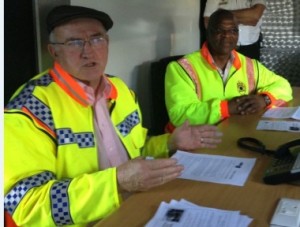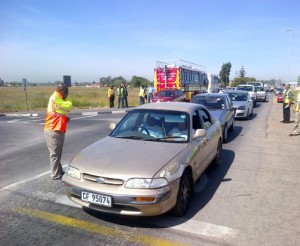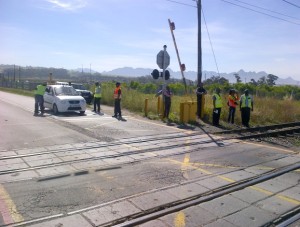“The tragic events of 25 December 2010 should never be forgotten, and must continue to serve as a reminder of the horror that reckless and irresponsible driving can inflict on those most vulnerable, namely passengers and pedestrians,” said Minister Carlisle.
“The initial CCTV level crossing camera enforcement project was the first of its kind in South Africa, targeted specifically at prosecuting level crossing offences. With this system, offenders will face stiff fines, starting at R500 for failure to stop before crossing the level crossing. They may also face arrest and charges of reckless and negligent driving, for example, if the booms are ignored. We have no doubt that the effects that this CCTV enforcement has had on White Road will also be felt at Buttskop, with drivers changing their behaviour and adhering to the rules of the road,” added Carlisle.
 |
 |
 |
|
Enforcement Statistics
Metrorail Western Cape regional manager, Mthuthuzeli Swartz, said the (80) near-misses at the Buttskop level crossing in ten months is maniacal: “Any one of those could have been fatal. We must force compliance through enforcement”. Swartz said the region’s approach to safety at level crossings will receive a welcome boost by the installation of a second camera: “Enforcement forms an integral part of regulating vehicle driver behaviour.”
“Some of the reckless and irresponsible acts seen at these level-crossings not only endanger lives, but also cause very costly damage to property; both being a serious disregard of the law that will inevitably adversely affect other road users for whom safety is a priority. Through these cameras we will be one step closer to ensuring that those errant motorists suffer the consequences of their actions,” added Carlisle.
“This year alone it had cost the rail utility more than R400 000 to repair booms driven off by errant motorists. It is unacceptable that good money is wasted on vandalism of this nature – this camera will ensure that guilty parties are fined and prosecuted with the full might of the law,” added Swartz.
“All level crossings in the region are evaluated regularly and have been assessed and found to fully comply with legal and statutory requirements. Some even exceed legally required safety measures. All Metrorail level crossings are checked and tested meticulously and damaged booms repaired within hours,” added Swartz.
Warning devices such as flash lights and booms are tested weekly and operational observations done daily. In addition road and rail crossing signage and road surface fixtures are inspected for vandalism and repairs every 90 days. Test results are documented in compliance to a stringent safety management system. Accident investigations happen under the auspices of the Rail Safety Regulator. Metrorail also serves on the regional cross-functional level crossing task team.
Way Forward with Level Crossings
The Western Cape government, and our partners, continues to look at ways in which to make level crossings safer, as well as move closer to the ideal where less and less vehicles have to make use of level crossings as a means of safe passage over railway tracks.
“One of our main projects to eliminate level crossings has been the joint venture project, co-funded by PRASA, at Vlaeberg level crossing. A contractor has been appointed to carry out the work of building a road over the rail bridge at Vlaeberg,” said Carlisle.
“The next step is indeed to consolidate or eliminate level crossings altogether. We have requested the City to honour their commitment to close Kenilworth level crossing after the completion of Stanhope Bridge,” said Swartz. He added that Metrorail’s principal, the Passenger Rail Agency of South Africa (PRASA), planned to develop suitable proposals to eliminate Koelenhof/Elsenberg, Buttskop and Military Road level crossings. These projects are in conceptual planning phase to develop road-over-rail bridges.
“Although PRASA has initiated the projects, are doing the planning and will avail funding, full implementation will require co-funding from municipal and provincial government. Construction timing will depend on the eventual costing and available budget. It is expected that construction of at least one will start in the financial year 2015/16 and the estimated construction period is 20 months,” added Swartz.
Level Crossing Facts and Safety Tips
· Safety at level crossings is predominantly governed by the principles contained in South African Road Signs Manual – road signage and lights at level crossings are the primary indicators; barriers or booms are affixed as additional barriers.
· Train drivers are obligated to sound sirens on approach to level crossings
· Trains operate with their head lights on as additional safety measures
· Trains LEGALLY have right of way at road/rail level crossing intersections.
· Trains operate on fixed infrastructure and cannot take evasive action during emergencies
· A full train will take up to 500 meters to stop under emergency conditions.
· Where level crossings are protected by lights and barriers, the lights will start flashing 30 seconds before an approaching train enters the level crossing intersection.
· Barriers drop 10 seconds before the train enters the intersection and remain closed until the last carriage safely clears the intersection. Lights continue to flash until the barrier lifts.
